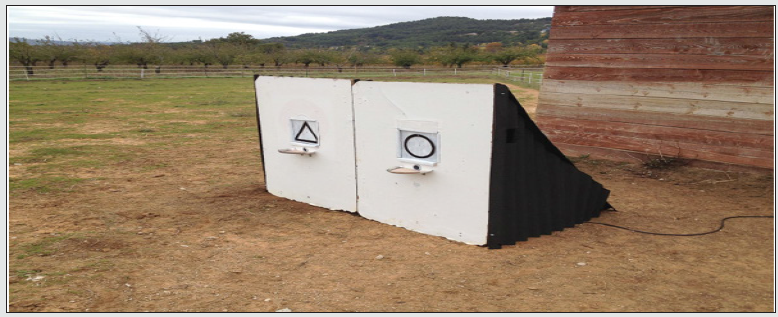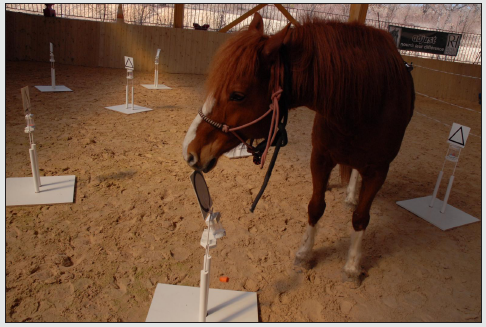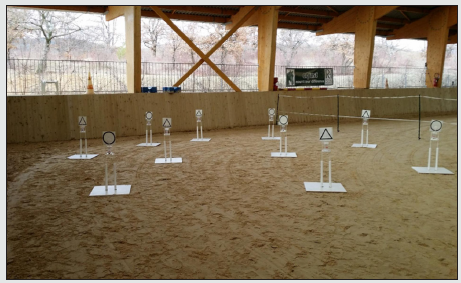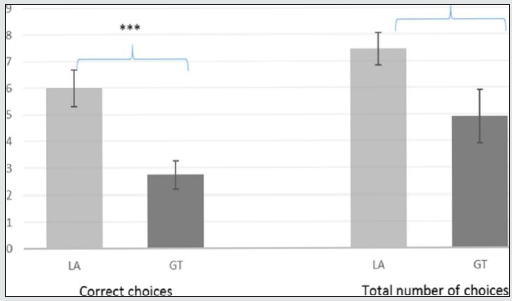
Lupine Publishers Group
Lupine Publishers
Menu
ISSN: 2641-1768
Research ArticleOpen Access
Generalisation Abilities of Learned Tasks in Horses (Equus Caballus) are Influenced by the Experimental Context Volume 5 - Issue 3
Tiago Mendonça1, Alessandro Cozzi1, Eva Teruel1, Manuel Mengoli2, Philippe Monneret1 and Patrick Pageat1*
- 1Research Institute in Semiochemistry and Applied Ethology (IRSEA), Quartier Salignan, 84400 Apt, France
- 2Manuel Mengoli, 260 route des Trécassats, 5 lotissement les Clos, 84400 Apt, France
Received:July 19, 2021 Published:July 27, 2021
Corresponding author:Patrick Pageat, Research Institute in Semiochemistry and Applied Ethology (IRSEA), Quartier Salignan, 84400 Apt, France
DOI: 10.32474/SJPBS.2021.05.000214
Abstract
The generalisation of responses to different stimuli depends on the ability to create associations between stimuli. Stimulus generalisation can be performed for different stimuli or for different contexts in which the same stimulus is perceived. This study investigated the stimulus-generalisation abilities of horses in different contexts. Sixteen horses were involved in this study. During the learning activity (LA), horses were given the chance to choose between two geometrical figures (a triangle and a circle) to obtain a food reward; the circle always corresponded to the correct choice. The rule was considered learned if a horse was correct more than 70% of the time and made 4 consecutive correct choices. Then, a generalisation test (GT) with ten devices (5 circles, 5 triangles) was created to test generalisation. Only eleven horses respected the learning criteria and were included in the generalisation test. A significant difference in the number of correct choices between the learning activity and the generalisation test was observed (Wilcoxon signed-rank test, S=-33; p=0.001; LA: median=6, min=3, max=9; GT: median=3, min=0, max=5). There was no significant difference in the number of incorrect choices between the two tests (Student’s t test, t=-0.91; DF=10; p=0.384). A significant difference in the total number of choices between the two tests was observed (Student’s t test, t=2.56; DF=10; p<0.05). This experiment suggested limits in the capacity of horses to generalise a well-known task in different contexts. Because horses are often exposed to different environments or contexts, these results provide interesting and applicable knowledge for equine training and management.
Keywords: Behaviour; Equine Management; Generalisation; Horse; Learning; Welfare
Introduction
Horses are involved in many activities that have evolved over time and have changed the human-horse relationship [1]. Currently, horses perform sports and work activities that require adaptation to different contexts [2,3]. Horses are continuously challenged from physical and psychological perspectives and need to understand information provided by different persons or in different contexts [3,4]. To succeed in equitation, horses must learn different categories of exercises that are demanded by riders [5]. However, rider weight and posture, as well as the intensity applied to cues, are variable, which often results in differences in the information perceived by the horse [6]. Nevertheless, horses have an incredible behavioural flexibility that allows them to adapt their responses to the intensities of the cues given by different riders [7-10]. In addition, horses are athletes that often participate in competitions. Competition has been shown to induce physiological modifications in horses related to stress [5-11]. In competition, riders expect their horses to ignore external stimuli and to perform as usual in response to trained cues, which requires horses to generalise those cues from a training environment to a new context with multiple stimuli, such as the presence of the public [11]. The same situation might happen each time horses experience a change of ownership or a change in their living conditions [12]. To summarise, equine living conditions, training and competitions are full of different stimuli that challenge horses’ coping strategies [13-15]. In this context, it is important to understand that the generalisation of a stimulus implies that animals can form associations between different stimuli (Nicol, 2005). Horses are requested to generalise their responses to different stimuli over training, either through positive or negative reinforcement [7]. Stimulus generalisation could be performed from a group of stimuli with some similarities (e.g.: curved shapes) to a novel stimulus, which share the same similarities (e.g.: a circle) [16]. However, stimulus generalisation may also occur as the generalisation of a defined stimulus to different contexts [17]. Stimulus generalisation to new contexts appears to be difficult for horses [18-20].
Hence, the generalisation of a well-known stimulus to different stimuli is a factor in equine management and welfare [5]. This means that providing more efficient and reliable training methods for riders and owners can increase the welfare of horses [6,11]. Therefore, to efficiently improve horse welfare in equine husbandry and training, riders and owners should learn from scientific knowledge instead of following common beliefs [15]. The present study aimed to investigate the ability of equines to generalise a learned task, based on the same rule, to different contexts. We hypothesised that horses would show the generalisation of a learned stimulus to a novel test in a different setting.
Methods
Subjects
Sixteen horses (11 geldings; 5 females) older than eighteen months (11.5 ± 6.14 years) were involved in this study. All horses participated in equestrian activities on a daily basis. A visual examination was performed by a veterinary doctor to ensure that none of the animals had vision issues that could impair the tests. This study was divided into two learning events. All animals were submitted to a learning activity (LA), which was a reproduction of the test used. The LA intended to show the discriminative rule to the horses, enabling the selection of a population of horses that understood the rule before performing the second test. The discriminative rule was considered learned if a horse was correct more than 70% of the time and made 4 consecutive correct choices. Only horses that respected these criteria were included in the second test, which was a generalisation test (GT).
Material
“Philbox”, the dispositive adapted and he was used for the LA in this experiment (Figure 1). The device consisted of two white panels; removable black shapes (a circle or a triangle) could be placed in front of the panels, and a hidden operator could insert treats on a food tray through a hole under each shape. A second operator led the horses to the panels. Ten “Pesadelo” devices were created to test the equine generalisation abilities (Figure 2). Each of these devices included a tilting mechanism, with one black shape painted on a white panel on the top (5 had a circle, and 5 had a triangle) and an inverted container on the bottom. Treats were placed in the containers, which each had a cover. For all devices marked by a circle, this cover was pierced such that the treats fell on the ground when the animals pushed or pulled the panel. For devices marked by a triangle, the cover was intact, so the treats did not fall when the animal pushed or pulled the panel. Some holes were created on the container to ensure that both devices had the same odour, regardless of cover type. There was a tray under each container. No operators were needed to run this device.
Figure 1: Philbox. The Philbox is a modified device for performing cognitive tests. The Philbox includes two removable geometrical shapes (circle and triangle) and a hidden operator who provides treats when the animals touch the panel with the correct shape.

Figure 2: Pesadelo. A Pesadelo is a device created to perform cognitive tests. The device includes a tilting mechanism with a shape-marked panel on one side and a treat in a container on the other side. To obtain the treat, a horse must push the panel (circle or triangle), such that the shape-marked panel tilts down and forward, the container tilts up and backward, and the treat drops onto the floor.

Procedure
A habituation session to the Philbox device was performed, as described. The setting was presented to the subjects, and spontaneous approaches and interactions with the device were rewarded with a treat. The session consisted of twelve efforts with the shapes removed from the devices. The initial phase of the session included 6 attempts (3 on the right and 3 on the left) using a treat on the panels as a lure; an additional reward was given each time the horses touched the panels. The horses then made 6 more attempts, for which they received a reward only upon touching the panels. A habituation session for the Pesadelo device was also performed to show horses the mechanism of pushing/pulling the panel to obtain treats. For this session, two devices with the shape panel replaced by a whole white panel were used. Horses were given 3 minutes of free contact with the two devices, in which any spontaneous contact with the panel was reinforced with a treat that felt from the container. For this purpose, each time a horse obtained a treat, an operator led the horse to the other device, while a second operator refilled the empty container with treats.
The LA were performed using the Philbox device and lasted five minutes for each horse. Horses had the possibility to choose between the shapes and received a reward (food treat) upon touching the correct shape (always the circle) with their noses (positive reinforcement). The development of a side preference was avoided by following predefined sequences of four figures, with a randomised order of appearance, thus avoiding any recognisable pattern. In addition, a food treat was hidden behind each shape to provide the same olfactory cue for both the circle and triangle. There was no limit to the number of attempts horses could perform during the 5 minutes of the test. Once a choice was made, horses were walked around by the operator and returned to the starting position. Thus, the horses that made choices faster could perform more attempts during the 5 minutes of the test. Each horse was led to a distance of 1.5 metres in front of the panels and then freed to interact with the setting. The operator stopped at 1.5 metres, stayed in a neutral position, and did not interact with the animal until a choice was made. Horses that made 70% or more correct choices, with at least 4 consecutive correct choices, were subsequently included in the GT. There was a time lapse of 48 hours between the two tests for all horses. The GT lasted 5 minutes for each horse. The setting consisted of ten Pesadelo devices (5 circles and 5 triangles) placed in a controlled testing area inside of a riding arena (Figure 3). Each device provided only one treat. The devices were randomly positioned in the setting area to permit the horse to easily access the two options (triangle and circle). Each horse was completely free in the testing area, and the operator left the riding arena and the visual field of the horse. The performance parameters for both tests included correct and incorrect choices and the total number of choices. For the GT, a choice was considered correct both the first and second time a horse pushed/pulled the same panel with a circle, even if the treat reward was only achieved during the first interaction. The same rule was applied for incorrect choices. If the horse returned to the same device a third time, that choice was not considered, neither correct or incorrect. Each horse was considered its own control.
Figure 3: Generalisation test setting. Ten Pesadelo devices were positioned in a controlled area to test equine generalisation capacities.

Statistical Analysis
Statistical analysis was carried out using 9.4 SAS software (2002-2012 by SAS Institute Inc., Cary, NC, USA). The significance threshold was classically fixed at 5%. Comparisons among the horses’ performances during the LA and the GT involved paired samples. To use the paired Student’s t test, normality was tested on the difference of the results in the LA and in the GT for the following parameters: “correct choices”, “incorrect choices” and “total number of choices”. For the “correct choices”, assumption of normality was not verified, so the non-parametric signed-rank Wilcoxon test was preferred. Normality was verified for “incorrect choices” and “total number of choices”; hence, the parametric Student t test was used.
Results
From the 16 initial horses, five did not learn the discriminative rule, so they were not included in the GT. The final population of horses comprised 11 subjects (7 geldings; 4 females). Only these horses were considered for the statistical analysis. Figure 4 compares these horses’ performances between the two tests. A significant difference in the number of correct choices between the learning activity and the generalisation test was observed (Wilcoxon Signed-Rank test, S=-33; p=0.001; LA: median=6, min=3, max=9; GT: median=3, min=0, max=5). Horses made two times fewer correct choices in the GT than in the LA. There was no significant difference in the number of incorrect choices between the two tests (Student’s t test, t=-0.91; DF=10; p=0.384).
Figure 4: Comparison of horses’ performances in the two tests (mean ± SD of choices). The learning activity is represented by light grey, and the generalisation test is represented by dark grey. ***: highly significant p-value, p=0.001; *: significant p-value, p<0.05.

A significant difference was observed in the total number of choices between the two tests, (Student’s t test, t=2.56; DF=10; p<0.05). Horses made a greater number of choices in the LA than in the GT.
Discussion and Conclusion
This experiment showed that horses who learned a specific discrimination task had a lower performance when the task was presented for the first time in a different context and setting. This result was emphasised by the decrease in the total number of choices and the number of correct choices between the learning and the GTs. The absence of a significant difference in the incorrect choices between the tests was probably related to the reduced total number of choices in the GT when compared to the LA. Horses made fewer attempts in the GT and often chose the wrong shape or device. The decrease in the horses’ performance between tests suggests that the generalisation of a learned task between contexts might require training and repetition. Even if the discriminative rule had been the same in both tests, the setting was completely different. The GT involved a three-dimensional setting with multiple devices, with only one positive reinforcement per device. For the LA, horses had panels simultaneously presenting all possible choices in their visual field, while for the GT, it was essential for horses to walk between the devices to reach all of them. The new context of the test can have impacted the performance in the GT. In addition, for the LA, an operator was always present. His presence could have represented a help for the animal. However, in our study, the operators were trained to stay in a neutral position and avoid any interaction with the horses to prevent them from influencing the horses’ choices. One could argue that the time (i.e. 48h) between tests could have a role in memorisation and, consequently, the generalisation of the rule. Nevertheless, memory in horses seems to be reliable and longlasting through life, as described by Hanggi and Ingersoll (2009).
Our results differ from those of Christensen et al. (2008), who conducted a study in which horses were submitted to a GT between stationary objects of the same colour with varying shapes in the same setting conditions. That study changed the rewarded shape between tests, while in the present study, the rewarded shape (the circle) remained the same between tests, but the setting was changed. Therefore, the generalisation of a well-known stimulus might depend on the context and environment [20]. This hypothesis is supported by the results, who created a setting with a lever near two buckets in an area open to horses. Horses learned that once they pressed the lever, they could have a food reward. Then, in a Y-maze test, a lever pointed to the direction of the correct side of the maze, where horses could find a food reward. They found that horses’ performance decreased from the bucket test to the Y-maze test. Even if the rule, i.e. the presence of a lever, was the same to obtain a food reward in both tests, the manner to follow the rule was different. Indeed, horses are accustomed to exploring new objects by touching or licking them; therefore, the exploratory behaviour of horses may have spontaneously provided the manners to use the lever to get a reward. However, in the Y-maze, this natural behaviour does not lead to any reward, so horses probably needed to find new coping strategies, which requires time and experience. Conversely, in our study, horses could obtain the reward by following the same rule with the same manner in the two tests, i.e. by pressing on a circle, which provided the same reliable information that horses could use for both tests. We observed a decrease in horses’ performances between the two tests, indicating that context features other than the manner to follow the rule can influence the generalisation abilities of horses.
Research findings are of great importance and should be considered in equine welfare and management because these findings often contradict commonly held beliefs about equine cognition and learning abilities [10-16]. Horses are part of a worldwide market and are moved across countries, which often implies regrouping with other conspecifics [18].
The ease of habituation to new living conditions is a serious welfare concern in horses that often results in misunderstandings in the human-horse relationship [4,6]. For example, if a horse is moved to novel husbandry conditions, its behavioural response to a well-known stimulus and the resulting coping strategies could be different from the original response and strategies, and these differences could be justified by the context modification, regardless of the horse’s previous habituation to that stimulus. The same problem could occur during competition because horses must perform previously learned exercises in new contexts [5]. In conclusion, this experiment suggested some limits in the capacity of horses to generalise a well-known task to different contexts. This study demonstrated that horses’ perception of different stimuli is context specific. Increasing our knowledge about the generalisation abilities of these animals is of great importance to improve equine management and training. Further research is still needed to fully understand horses’ generalisation abilities, especially focusing on the ability to generalise similar information in the same context, and to measure the influence of this ability on equine management and training.
Highlights
Horse’s ability to generalise responses to similar stimuli is essential in equitation. Generalisation abilities influence the success of horses involved in competition. Horses have some limits in their ability to generalise learned stimuli. Generalisation abilities have an impact on equine’s welfare.
References
- Bartolomé E, Cockram MS (2016) Potential Effects of Stress on the Performance of Sport Horses.
- Journal of Equine Veterinary Science 40: 84-93.
- Brubaker L, Udell MAR (2016) Cognition and learning in horses (Equus caballus): What we know and why we should ask more. Behavioural Processes 126: 121-131.
- Cayado P, Muñoz Escassi B, Domínguez C, Manley W, Olabarri B, et al. (2006) Hormone response to training and competition in athletic horses. Equine Vet J Suppl 38: 274-278.
- Christensen J, Zharkikh T, Ladewig J (2008) Do horses generalise between objects during habituation? Applied Animal Behaviour Science 114(3-4): 509-520.
- Christensen JW, Søndergaard E, Thodberg K, Halekoh U (2011a) Effects of repeated regrouping on horse behaviour and injuries. Applied Animal Behaviour Science 133(3-4): 199-206.
- Christensen JW, Zharkikh T, Chovaux E (2011b0 Object recognition and generalisation during habituation in horses. Applied Animal Behaviour Science 129(2-4): 83-91.
- Hanggi EB, Ingersoll JF (2009) Long-term memory for categories and concepts in horses (Equus caballus). Anim Cogn 12(3): 451-462.
- Horseman SV, Buller H, Mullan S, Whay HR (2016) Current Welfare Problems Facing Horses in Great Britain as Identified by Equine Stakeholders. PLos One 11(8): e0160269.
- McCall CA (2007) Making equine learning research applicable to training procedures. Behav Processes 76(1): 27-28.
- McCall CA, Salters MA, Johnson KB, Silverman SJ, McElhenney WH, et al. (2003) Equine utilization of a previously learned visual stimulus to solve a novel task. Applied Animal Behaviour Science 82(3): 163-172.
- McGreevy P, McLean A (2010) Horses in Sport and Work, In: Equitation Science. Wiley-Blackwell, Oxford, United Kingdom, pp. 162-178.
- McGreevy PD, McLean AN (2007) Roles of learning theory and ethology in equitation. Journal of Veterinary Behavior 2(4): 108-118.
- Mengoli T, Bienboire Frosini C, Kowalczyk I, Leclercq J, Arroub S, et al. () Equine activities influence horses' responses to different stimuli: could this have an impact on equine welfare? Animals (Basel) 9(6): 290-300.
- Mengoli M, Pageat P, Lafont Lecuelle C, Monneret P, Giacalone A, et al. (2014) Influence of emotional balance during a learning and recall test in horses (Equus caballus). Behavioral Processes 106: 141-150.
- Nicol CJ (2005) Learning abilities in the horse, In: Mills, D., McDonnell, S. (Eds.), The Domestic Horse: The Evolution, Development and Management of Its Behaviour. Cambridge University Press, Cambridge, UK, pp: 169-183.
- Peeters M, Closson C, Beckers J, Vandenheede M (2013) Rider and Horse Salivary Cortisol Levels During Competition and Impact on Performance. Journal of Equine Veterinary Science 33(3): 155-160.
- Schmidt A, Aurich J, Möstl E, Müller J, Aurich C (2010) Changes in cortisol release and heart rate and heart rate variability during the initial training of 3-year-old sport horses. Horm Behav 58: 628-636.
- Von Lewinski M, Biau S, Erber R, Ille N, Aurich J, et al. (2013) Cortisol release, heart rate and heart rate variability in the horse and its rider: Different responses to training and performance. Vet J 197: 229-232.
- Williams J, Tabor G (2017) Rider impacts on equitation. Appl Anim Behav Sci 190: 28-42.

Top Editors
-

Mark E Smith
Bio chemistry
University of Texas Medical Branch, USA -

Lawrence A Presley
Department of Criminal Justice
Liberty University, USA -

Thomas W Miller
Department of Psychiatry
University of Kentucky, USA -

Gjumrakch Aliev
Department of Medicine
Gally International Biomedical Research & Consulting LLC, USA -

Christopher Bryant
Department of Urbanisation and Agricultural
Montreal university, USA -

Robert William Frare
Oral & Maxillofacial Pathology
New York University, USA -

Rudolph Modesto Navari
Gastroenterology and Hepatology
University of Alabama, UK -

Andrew Hague
Department of Medicine
Universities of Bradford, UK -

George Gregory Buttigieg
Maltese College of Obstetrics and Gynaecology, Europe -

Chen-Hsiung Yeh
Oncology
Circulogene Theranostics, England -
.png)
Emilio Bucio-Carrillo
Radiation Chemistry
National University of Mexico, USA -
.jpg)
Casey J Grenier
Analytical Chemistry
Wentworth Institute of Technology, USA -
Hany Atalah
Minimally Invasive Surgery
Mercer University school of Medicine, USA -

Abu-Hussein Muhamad
Pediatric Dentistry
University of Athens , Greece

The annual scholar awards from Lupine Publishers honor a selected number Read More...




